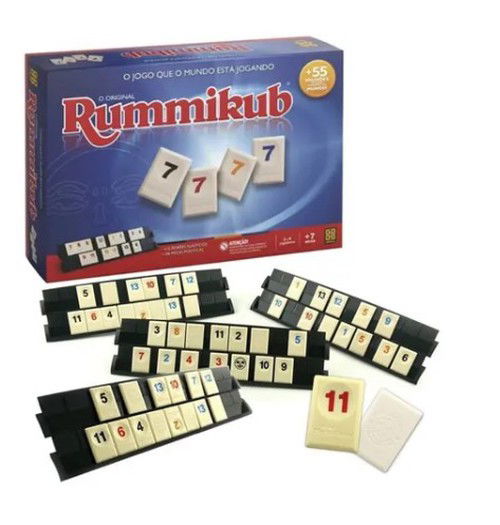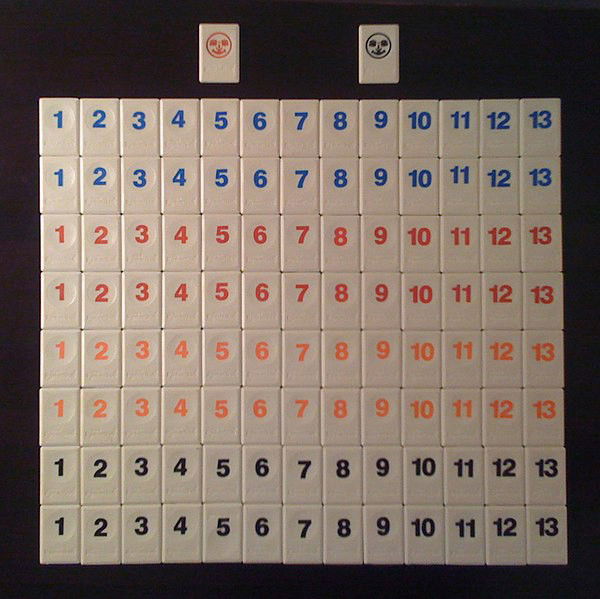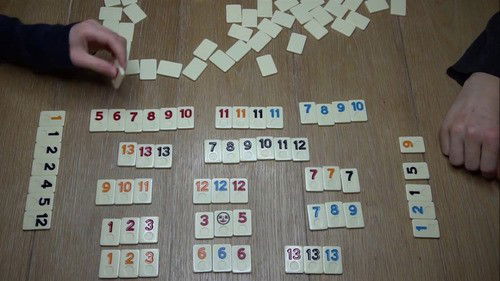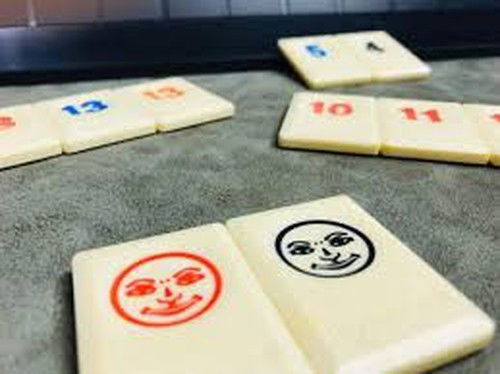Rummikub
Rummikub is a family game that doesn't abandon strategy and emotion with every move. Its success is also due to its combination of elements from several other games, from rummy (card game), Dominoes, Mahjong and Chess.

Don't be alarmed by having elements of so many games with high strategy and different levels of difficulty, Rummikub is really a family game, with the right dose of strategy and difficulties for a game of this category.
About the Game
Rummikub is a game for 2 to 4 players, age 8+, created in 1977 by Ephraim Hertzano.

It is an award-winning game, in 1980 it sold the famous Spiel des Jahres in Germany and in 1993 it won the Gra Roku in Poland, both as the best game of the year.
The Rummikub Official Book
That's right, a board game that won a book: The Rummikub Official Book. It brings, in addition to the rules, obviously, strategic and tactical tips. It has 72 pages and also describes the 3 different rules for the game: the “American”, the “Sabra” and the “International”. The version I am reviewing and the one currently sold use only the “Sabra” rule.

The American is the simplest of the three versions and the closest to the traditional rummy. Once you learn its basics, you can adapt it to other versions.
Sabra, the one we reviewed, adds more rules, and in my opinion, is the best. It's an easy game to learn, but the extra moves allowed in the Sabra version make it a game of bold and aggressive tactics, with incredibly fast actions. But, like Chess, it requires you to think ahead and visualize the variable configuration of the pieces. The game gets fast and furious as players try to make the most of the pieces they have within a strict time limit. It's much more fun!
The International rules make for a highly sophisticated game that bears a strong resemblance to Mahjong in having to complete a variety of patterns and winning combinations. The score is unusual, and the odds are for an ever-changing game.
In short, the Sabra version brings more challenges!
The Game
The game is simple, without ceasing to be strategic. As components, it has 104 tiles numbered from 1 to 13 in 4 different colors: black, orange, blue and red, in addition to 2 Jokers, and finally, it has 4 racks for the tiles.

Basically, you have to play all the tiles from your racks. Simple as that, however, there are some rules that bring the long-awaited strategy.
At the beginning of the game, players receive 14 tiles and place them in their rack, then, to start playing them, you need to form groups or sequences in the total value of 30 points in the sum of all tiles, only then will you “enter” the game, otherwise, every round you don't “enter”, you draw a tile from the table.

Opening
Well, where does the strategy come in there? As already said, to "enter" the game, to have the 30 points, you can use groups (example: 4 tiles of value 7 of different colors) and/or sequences (example: 4 tiles in values 3, 4, 5 and 6 of the same color), as long as they add up to 30 points together.
Remembering that for both groups and sequences, 3 or more tiles are required. This act of “entering” the game is called Opening. It is worth mentioning that the games on the table (both groups and sequences) have no owner, everyone can use them to help play their tiles.
The start of the game can be a little slow, as scoring 30 points is not that trivial. The rules manual says that both the number of points for the Opening and the time for each player's turn can be changed according to the desired difficulty level.
Moves
After the Opening, the game really shines, the so-called Moves happen. Immediately after the Opening, you can perform Moves, including the tiles that you yourself have put into play.

But what are Moves? They are the soul of the game! Drop more pieces from your rack using as a basis the games (groups or series) already played on the table, fitting your pieces, thus getting rid of them. Please keep in mind that the golden rule is that each game on the table must have at least 3 tiles. Respecting that, it's time to execute your strategy.
So, the game continues with the players getting rid of their pieces through the most amazing and unimaginable Moves, being able to change everything. Undo groups, separate sequences, and so on, as long as at the end, I repeat, all games on the table have at least 3 tiles.
Flavor
I haven't even mentioned the Jokers yet. Ah, that's when things start to heat up. The Joker performs the function it brings in its name, as it is a Joker it can replace any piece. And strategy here is very useful.

What if I can't play a tile on my turn? Well, you won't get away with it. As a punishment, you have to take 1 tile from the pile (not from the ones in play) and with that, your rack will fill up again.
Oh, and if I start performing Moves, will my time run out? Well, that is possible, and indeed, it happens often. If at the end of your time you haven't played any tiles, return the Moves to the starting position and as a penalty draw 3 tiles from the pile.
I said time running out, correct? Well then! Can I think for several minutes about my chances on my turn, thus delaying the table and making the game boring? Of course! The game suggests a maximum limit of 1 minute for each player to perform their moves on their turn. This makes the game much more dynamic.
There's an app is called “Rummikub Score Timer” which has a configurable clock for as long as you want, and you can also put the names of the players and mark the score.

There are several other ways to do this, including a house rule to play without time, if you are starting the kids. Anything goes, the important thing is to have fun.
End of Game and Scoring
The end of the game happens when a player manages to play all of their tiles, then the score is given. Each tile has a number printed on it, and the sum of all the tiles on your board will be your negative score. Ah, if you have the Joker in your rack, it adds 30 points of damage.
The player who played all the pieces scores positively the sum of the negative total of all players, only, obviously, positively, that is, the sum of the losses of the other players is their positive score.
Gameplay
Strategic Tips
Rummikub is a feast for those who like strategic games.
First, optimize your time following the progress of the game, the groups or sequences that are forming, breaking up, having half-thought about what you will do during your turn, since the time will be short.
At the beginning of the game, it is strategic to hold on to some tiles that were already possible to be played, so you force the other players to play more games or perform more moves and remember, the more games at the table, the more moves we'll have available.
Sometimes, it's worth that even if you have a group or sequence with 4 tiles, choose to play only 3 of them. This gives you a better chance of not going blank next turn and not having to take one from the pile.
Keeping the Joker in your support can be a good tactic, but mind you, if someone is near the end of the game, that Joker can take you 30 points down. Use it wisely!
The general idea is to always have at least one tile to drop when it's your turn. For this, it is worth holding some tiles, or the Joker in some games. Anyway, it is possible to go to the extreme of spending a turn with no actions, even if it costs you to pick up a tile from the pile, to have more options in the next turns.
End of Game
The game ends after 3 full games, the player with the highest positive balance wins.
Teaching Tips for Rummikub
Rummikub, in addition to being fun and very strategic, helps to develop mathematical logical reasoning, thus favoring the construction of mathematical knowledge.
You can use Rummikub to teach numbers, colors, group formation and number sequences. It is, undoubtedly, an excellent teaching tool for children. They will learn by playing, literally.
I recommend Rummikub in your collection!














— 评论 0
, 反应 1
成为第一个发表评论的人